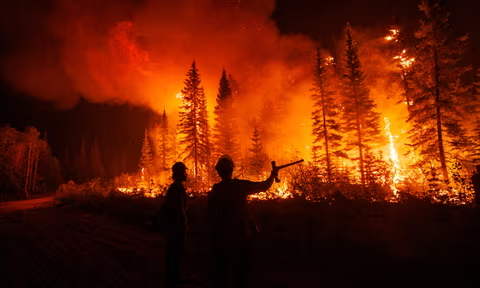The Outbreak and Spread of the Jones Road Wildfire
The wildfire began on Tuesday afternoon, April 22, 2025, in the densely wooded Greenwood Forest Wildlife Management Area. Due to dry conditions and gusty north winds reaching speeds up to 20 mph, the fire quickly spread beyond Barnegat Township into neighboring Ocean and Lacey Townships. The rapid expansion of the blaze caught many residents off guard, prompting urgent evacuation orders.
By Wednesday morning, the wildfire had consumed nearly 8,500 acres, making it one of the largest wildfires in New Jersey’s history. The fire’s intensity was exacerbated by an ongoing drought affecting the region, which has seen below-average precipitation throughout the winter and early spring months.
Evacuations and Emergency Response
More than 3,000 residents were ordered to evacuate as the fire threatened homes and businesses in Ocean County. Evacuation centers were established at Southern Regional High School in Manahawkin and Manchester Township High School to provide shelter and support for displaced families.

Local and state emergency services, including the New Jersey Forest Fire Service, Ocean County Office of Emergency Management, and multiple fire departments, mobilized swiftly to combat the blaze. Firefighters worked tirelessly to establish containment lines and protect critical infrastructure.
One of the major challenges faced by responders was the fire jumping the Garden State Parkway, a vital north-south highway in New Jersey. The blaze forced the closure of a significant stretch of the parkway, causing traffic disruptions and complicating evacuation efforts.
Power Outages and Infrastructure Impact
The wildfire’s proximity to residential areas and utility infrastructure led to widespread power outages. Jersey Central Power and Light Company proactively cut electricity to over 25,000 customers in the affected areas to prevent further hazards such as downed power lines sparking new fires.
Restoration crews have been working around the clock to safely restore power as containment improves. The outages added to the difficulties faced by residents already displaced by the fire.
Containment Efforts and Weather Forecast
As of the latest reports on April 23, 2025, firefighting teams have achieved approximately 10% containment of the Jones Road Wildfire. Crews continue to battle the blaze through controlled burns, water drops, and ground operations.
Fortunately, a high-pressure system is expected to bring calmer winds later in the day, reducing the fire’s spread. Additionally, rain is forecasted to begin Friday night, which could significantly aid containment efforts and help alleviate drought conditions. More
The Role of Drought and Climate Factors
New Jersey’s ongoing drought has played a critical role in the severity of the Jones Road Wildfire. The state has experienced below-average rainfall for several months, leaving forests and vegetation dry and highly flammable. This drought warning issued by the New Jersey Department of Environmental Protection highlights the increased risk of wildfires in the region.
While wildfires are more common in western U.S. states, this event underscores how changing climate patterns and prolonged dry spells can increase wildfire risks even in areas traditionally less affected.
Community Response and Support
The wildfire has brought the Ocean County community together in support of those affected. Local organizations, volunteers, and emergency responders have provided food, shelter, and assistance to evacuees. Efforts to support displaced families and protect wildlife in the Greenwood Forest Wildlife Management Area are ongoing.
Residents are urged to stay informed through official channels, adhere to evacuation orders, and prepare for potential future fire risks as the dry season continues.
Looking Ahead: Prevention and Preparedness
The Jones Road Wildfire serves as a wake-up call for New Jersey and similar regions to enhance wildfire preparedness and prevention strategies. This includes:
- Increasing public awareness about fire safety and evacuation procedures
- Improving forest management and controlled burn practices
- Investing in firefighting resources and training
- Monitoring drought conditions and issuing timely warnings
As climate change continues to impact weather patterns, states like New Jersey must adapt to new environmental challenges to protect communities and natural resources.
Conclusion
The 2025 Jones Road Wildfire in New Jersey was a stark reminder of the growing wildfire risks beyond traditional hotspots. With over 8,500 acres burned, thousands of residents evacuated, and critical infrastructure affected, the event highlighted the importance of preparedness, rapid response, and community resilience.
Thanks to the tireless efforts of firefighters and emergency personnel, containment is progressing, and hopes are high that upcoming weather changes will help bring the fire under control. As New Jersey recovers, the lessons learned from this wildfire will be crucial in safeguarding the state against future fire emergencies.
